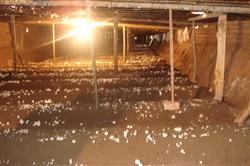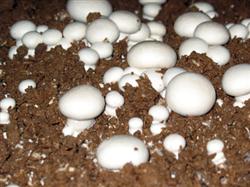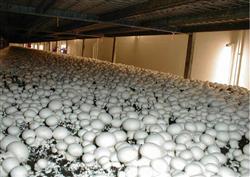Integrated control of diseases and insect pests of Pleurotus ostreatus

1 miscellaneous bacteria, diseases, insect pests and their control 1.1 miscellaneous bacteria and their control methods 1.1.1 Ghost umbrellas are commonly known as wild mushrooms, morphological characteristics: the cover is initially warhead-shaped or oval, jade white, gray-white or yellow-white, with scales on the surface, slender stalks and hollow. When the mature cap unfolds, the fold changes from white to black gradually, and finally dissolves into ink with the cap. Prevention and treatment methods: pile up the culture material, increase the heap temperature, reduce the ammonia content, and prevent the culture material from being too raw and too wet, so as to restrain the occurrence and growth of ghost umbrella. After ghost umbrellas are produced on the mushroom bed, they should be removed in time; if ghost umbrellas occur greatly, they can be prevented and treated with 2%-5% formaldehyde solution. 1.1.2 White gypsum mold, also known as stinky mold, morphological characteristics: at the beginning of the double spot block dense hyphae, gradually become deep * flour, there is a pungent smell. Prevention and treatment: increase the amount of calcium superphosphate and reduce the pH value of the culture material: after local occurrence, spray 50% carbendazim wettable powder 500 times. 1.1.3 dirt drum bacteria, also known as rubber gyroscope, Tricholoma Mengzui, dung bowl, morphological features: flora or clump, short handle, gyroscope stretched in a shallow cup shape, diameter 1: 4.5 cm, height 1: 2.5 cm, outer dark brown, with clusters of villi, wrinkled when dry, poisonous. Prevention and control methods: the joint company of raising bacteria should be properly ventilated to reduce humidity; remove the bacteria of dirt gum drum in time and bury them deeply; when local occurrence occurs, spray 2%-5% formaldehyde solution to prevent and control. 1.2 insect pests and their control methods 1.2.1 White adults are grayish blue, small in size, soft and wingless, and rarely exceed 5 mm in length. Mainly bites on the fruiting body, usually invading from the wound or bacterial fold. Prevention and control methods: when the insect is found on the bed, it can be sprayed with 1000 times of 80% trichlorvos EC or 500 times of omethoate EC, or with 1000 times of 80% dichlorvos EC plus a small amount of honey. 1.1% compound Sophora flavescens 500x solution can be sprayed to prevent and kill, or 80% trichlorvos EC 1000 times solution plus a small amount of honey can be used. 1.2.2 the adult of Mushroom fly is 6-9 mm long and dark gray. The larva is 8-12 mm long, white, with a pointed head and a blunt tail. The pupa is long oval, 6-8 mm long, reddish brown to dark brown. Control methods: install screen windows in the mushroom room to prevent the entry of mushroom flies; when adults are found in the mushroom room, 0.5 parts of liquor, 2 parts of water, 3 parts of brown sugar and 3.5 parts of vinegar can be used to trap and kill with a small amount of trichlorfon or dichlorvos in the basin. 1.2.3 Mushroom mosquitoes generally have a length of 4.5 mm to 6.0 mm for adults and 10 mm to 13 mm for larvae. Adults have phototaxis and have strong ability to fly. Control methods: mosquitoes were found before mushroom emergence and fumigated with dichlorvos; after mushroom emergence, castor leaves were mashed, extruded juice, mixed with 10 parts of water and 1 part of ∶ juice, boiled and cooled, sprayed in the mushroom room and on the noodles. 1.3 Disease and its control methods 1.3.1 Brown spot is also called dry bubble disease, verticillium mildew and so on. It takes about 2 weeks for mushrooms to develop brown spots from susceptibility to disease. At first, there are many irregular needle-sized brown spots on the mushroom cover, and then the spots gradually expand and produce depressions, which are gray. Control method: spray 50% carbendazim wettable powder 500 times solution. 1.3.2 after infection, the fruiting body of soft rot gradually turns brown until it rotts. Prevention and control methods: reduce bed water spraying, strengthen ventilation, reduce air humidity, sprinkle lime powder to the diseased area; spray 50% carbendazim wettable powder 800 times. 2.1.The pH value of culture material should be adjusted to 7.5-8 before entering the greenhouse. If it exceeds 8.2, it is easy to cause the occurrence of white gypsum mold. If the pH value is too high, adjust it with calcium superphosphate water; if it is too low, use lime water. 2.1.2 the day before entering the shed, the disinfection culture material should spray 80% dichlorvos EC 200 times or 40% omethoate EC 400 times on the surface of the stack, and then seal for 24 hours to kill mites and other pests. 2.2 disinfection of mushroom 2.2.1 disinfection of empty room with 15 grams of sulfur, 2 milliliters of formaldehyde and 5 milliliters of 80% dichlorvos EC per cubic meter, mixed in sawdust, packed in paper bags, placed in the four corners and center of the mushroom room, sealed doors and windows, then lit and smoked for 24 hours. Or every 100 square meters of bed with 2 kg of formaldehyde, 1 kg of dichlorvos fumigation for 24 hours, and then open the window for air. If it is a continuous stubble mushroom house, after collecting the mushrooms, all the bedding that can be removed should be removed in time, and moved to the outside for thorough cleaning and exposure; if it cannot be removed, the plastic film should be exposed to the sun for several days, and the walls should be sprayed with 10%-20% lime water. Seal the mushroom room before use, and then fumigate and disinfect according to the above method. 2.2.2 disinfection of the real house every 100 square meters of the bed is heated and fumigated with 1 kg of formaldehyde, sealed for 24 hours, and then open the vents for ventilation. 2.3.The adjustment and disinfection of the pH value of the covered soil 2.3.1 spray the soil particles evenly with 5% formaldehyde solution, hang them slightly, spray them with a 500x solution of 80% dichlorvos EC, and then seal them with a film for 24 hours. 2.3.2 the pH value of soil particles is adjusted by lime, and the suitable pH value is about 7.5-8 for pH value. 2.4 Protection of vents all vents are covered with gauze to prevent various pests from flying in.
- Prev

Causes and preventive measures of common problems in the outbreak period of Pleurotus ostreatus
Miscellaneous bacteria and their control methods commonly known as wild mushrooms, morphological features: the cover is initially warhead-shaped or oval-shaped, jade white, gray or yellow-white, the surface is mostly scaly, the handle is slender, hollow. When the mature cap unfolds, the fold changes from white to black gradually, and finally dissolves into ink with the cap. The prevention and cure method heaps up the culture material.
- Next

Eight points for attention in the control of diseases and insect pests of Pleurotus ostreatus
By strengthening the comprehensive management of the cultivation of Pleurotus ostreatus, creating an environment conducive to the growth of Pleurotus ostreatus but not conducive to the reproduction of diseases and insect pests is the key to the growth of organic Pleurotus ostreatus. 1. Do a good job in environmental hygiene. Seed production and operators must establish a normal clean and sanitary management system, constantly remove pollutants and disinfect them with chemicals.
Related
- Fuxing push coffee new agricultural production and marketing class: lack of small-scale processing plants
- Jujube rice field leisure farm deep ploughing Yilan for five years to create a space for organic food and play
- Nongyu Farm-A trial of organic papaya for brave women with advanced technology
- Four points for attention in the prevention and control of diseases and insect pests of edible fungi
- How to add nutrient solution to Edible Fungi
- Is there any good way to control edible fungus mites?
- Open Inoculation Technology of Edible Fungi
- Is there any clever way to use fertilizer for edible fungus in winter?
- What agents are used to kill the pathogens of edible fungi in the mushroom shed?
- Rapid drying of Edible Fungi

